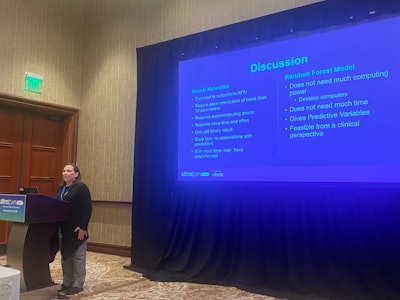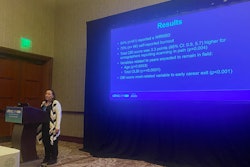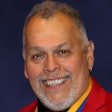AUSTIN, TX -- A machine-learning algorithm can predict burnout among sonographers, though established burnout indices may be enough, according to research presented April 9 at UltraCon 2024.
In her talk, Jennifer Bagley from the University of Oklahoma highlighted her team’s results, which show that a random forest AI model outperformed a neural network in predicting burnout and intention to leave the field and that burnout inventory scores are the most predictive variables.
“[Intention to leave the field] is something we can’t really afford to have at this day and time in our workforce, especially in the sonographer workforce,” Bagley said.
 Jennifer Bagley from the University of Oklahoma presents findings at UltraCon on the performance of two machine learning approaches in predicting burnout among sonographers.Amerigo Allegretto
Jennifer Bagley from the University of Oklahoma presents findings at UltraCon on the performance of two machine learning approaches in predicting burnout among sonographers.Amerigo Allegretto
Burnout continues to be a challenge for medical imaging as those who experience symptoms have an intention to leave the field. Previous reports indicate that sonographers have a burnout rate as high as 90%.
So, how can imaging leaders know who is most at risk for burnout? Bagley and colleagues employed two types of models, a neural network and a random forest model.
The researchers issued a 43-question survey to study participants with questions about the following: workplace culture, workload, intention to leave the field, work-related musculoskeletal disease disorders, and the Oldenburg Burnout Inventory. The latter is a validated inventory that assesses the severity of burnout symptoms experienced by employees.
The neural network used in the study was a two-layer deep-learning network with 200 nodes in each hidden layer. The data was split 500 times into testing and training cohorts. The random-forest model meanwhile used 500 total regression trees and was de-correlated with random variable selection. It used 1,000 pairs of training and data sets. Training data had 90 observations and test data had 28 observations.
The random-forest model achieved better accuracy in predicting burnout among the sonographers at 85% compared to the 73.4% achieved by the neural network. The performance was based on self-reported burnout by the sonographers. The neural network also achieved a sensitivity of 83.7% and a specificity of 43.4%.
The most predictive variables according to the random-forest model were total scores, disengagement, and exhaustion as measured by the Oldenburg Burnout Inventory. Of the noninventory variables, the team observed similar predictive values for gender, years planned to work, and years working.
Bagley said while the neural network was predicted to be the superior approach for the study, there are several reasons that may have capped its performance. These include the need to parameterize more than 10 parameters, more supercomputing power, and more time and effort. Additionally, it only provides the binary result and with more time, it may have outperformed the random-forest model.
The random-forest model, meanwhile, does not need as much computing power, does not need as much time, gives predictive variables, and is feasible from a clinical perspective, Bagley said.
That being said, Bagley suggested the Oldenburg Burnout Inventory may be enough to gauge burnout among sonographers.
“Honestly, if you just ask, you would get a pretty accurate answer to whether your sonographers are burned out,” Bagley said.



















